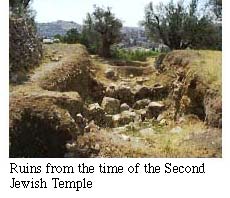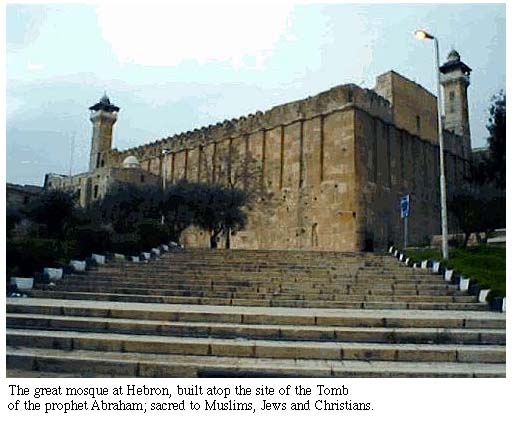This page provides detailed information about the ancient city of Hebron, one of the key cities in the Palestinian Authority. Many of the products featured on this site come from Hebron, which provides local markets for the people of Al-Kaabneh, located about 25 kilometers (15 miles) away on the edge of the Dead Sea desert. Photos of hisotrical sites, markets and people give a sense of the deep religious significance of this place, which is sacred to the Moslem, Jewish and Christian religions.
The Ancient Canaanite name for the city of Hebron is Arbo'a, which is derived from the word "four." It is believed that the city was called so because it is surrounded by four main mountains, or because the area hosted four confederated settlements in biblical times. An ancient Canaanite royal city, Hebron was founded "seven years before Zoan in Egypt" (Numbers 13:22). Zoan was the capital of the Hyksos invaders, and has been dated to the 18th century BC.
The present Arabic name of Hebron is Al Khalil, meaning "the friend." The city was named after Prophet Abraham who was called "Khalil" in the Quran:
In ancient Hebrew, the name for a nearby ancient settlement is Kiriath Arba: "the suburb of four." The Jewish holy scriptures say that the this name was given because four couples were buried there: Adam and Eve, Abraham and Sarah, Jacob and Leah, Isaac and Rebecca. For Muslims, Hebron is holy because the Magarat ("Cave") is located there, where Muslims believe that Abraham, the father of all the prophets, was buried. Muslims have an absolute belief in the prophecies of Abraham, Isaac and Jacob, as well as the Torah, as the word of God. In the holy Muslim book, the Quran, Abraham, Jacob and Isaac were named 73, 18 and 16 times respectively, as opposed to only 4 times for the prophet of Islam, Muhammad. Jews and Christians revere the Cave for the same reasons.
King David, the son of Solomon (c. 10th century BC) was ordered by God to go to Hebron; he was anointed king of Israel there, and made it his capital for 7-1/2 years, until the taking of Jerusalem (II Samuel 2-5). King Herod the Great (ruled 37-4 BC) built a wall around the cave of Mach-pelah, portions of which survive beneath additions by Byzantines, crusaders, and Mamluks. The Muslims ruled the city almost continuously from AD 635 until after World War I.
Modern Hebron is a city of 40,000 people: an agricultural, marketing and trade centre, with glass, brass, ceramic, pottery and leather crafts, as well as cotton products, olivewood carvings, dried fruits, fine grapes and wines, all found in a central bazaar over 3000 years old. Quarries in the surrounding hills export highly-prized, distinctive rose-colored stone and marble throughout the Middle East. The Cave of Mach-pelah in the center of the city is surmounted by a large mosque, al-Haram al-Ibrahimi al-Khalil (The Sanctuary of Abraham, the Friend). After the Six-Day War (1967), the tombs of the patriarchs were opened to all worshippers for the first time in exactly 700 years. Both Muslim and Jewish services are now held in the cave.  |
 Hebron
is
one
of
the
oldest
continuously
inhabited
communities
in
the
world.
Remains
dating
back
to
the
ancient,
middle
and
modern
stone
ages
have
been
found
in
Hebron.
Excavations
have
proven
that
the
history
of
the
city
can
be
traced
back
to
earlier
than
the
year
3500
B.C.
Recently,
archeologists
discovered
40
clay
jugs,
4000
years
old,
at
the
entrance
to
nearby
Tel
Hebron.
Hebron
is
one
of
the
oldest
continuously
inhabited
communities
in
the
world.
Remains
dating
back
to
the
ancient,
middle
and
modern
stone
ages
have
been
found
in
Hebron.
Excavations
have
proven
that
the
history
of
the
city
can
be
traced
back
to
earlier
than
the
year
3500
B.C.
Recently,
archeologists
discovered
40
clay
jugs,
4000
years
old,
at
the
entrance
to
nearby
Tel
Hebron. After
the
exodus
of
the
Jewish
people
from
Egypt,
Hebron
was
one
of
the
cities
visited
by
spies
sent
by
Moses.
Later,
Joshua
fought
the
Battle
of
Aijalon
near
here,
where
"the
sun
stood
still,"
against
a
confederation
of
Amorite
chiefs
including
the
"king
of
Hebron"
(Joshua
10).
Just
outside
the
village
is
the
mosque
of
Nabi
Yunus
which,
according
to
Muslim
tradition,
is
built
over
the
grave
of
the
prophet
Jonah.
During
the
time
of
Jesus
Christ,
some
houses
were
built
around
the
cemetery
wall,
which
soon
became
a
village
known
as
"House
of
Abrahim".
Jesus
visited
here
often,
and
there
is
an
active
Christian
community
in
modern
Hebron.
After
the
exodus
of
the
Jewish
people
from
Egypt,
Hebron
was
one
of
the
cities
visited
by
spies
sent
by
Moses.
Later,
Joshua
fought
the
Battle
of
Aijalon
near
here,
where
"the
sun
stood
still,"
against
a
confederation
of
Amorite
chiefs
including
the
"king
of
Hebron"
(Joshua
10).
Just
outside
the
village
is
the
mosque
of
Nabi
Yunus
which,
according
to
Muslim
tradition,
is
built
over
the
grave
of
the
prophet
Jonah.
During
the
time
of
Jesus
Christ,
some
houses
were
built
around
the
cemetery
wall,
which
soon
became
a
village
known
as
"House
of
Abrahim".
Jesus
visited
here
often,
and
there
is
an
active
Christian
community
in
modern
Hebron.
 The
Book
of
Genesis
tells
that
the
patriarch
Abraham
purchased
the
Cave
in
Hebron
for
the
full
market
price
of
400
silver
shekels:
The
Book
of
Genesis
tells
that
the
patriarch
Abraham
purchased
the
Cave
in
Hebron
for
the
full
market
price
of
400
silver
shekels: